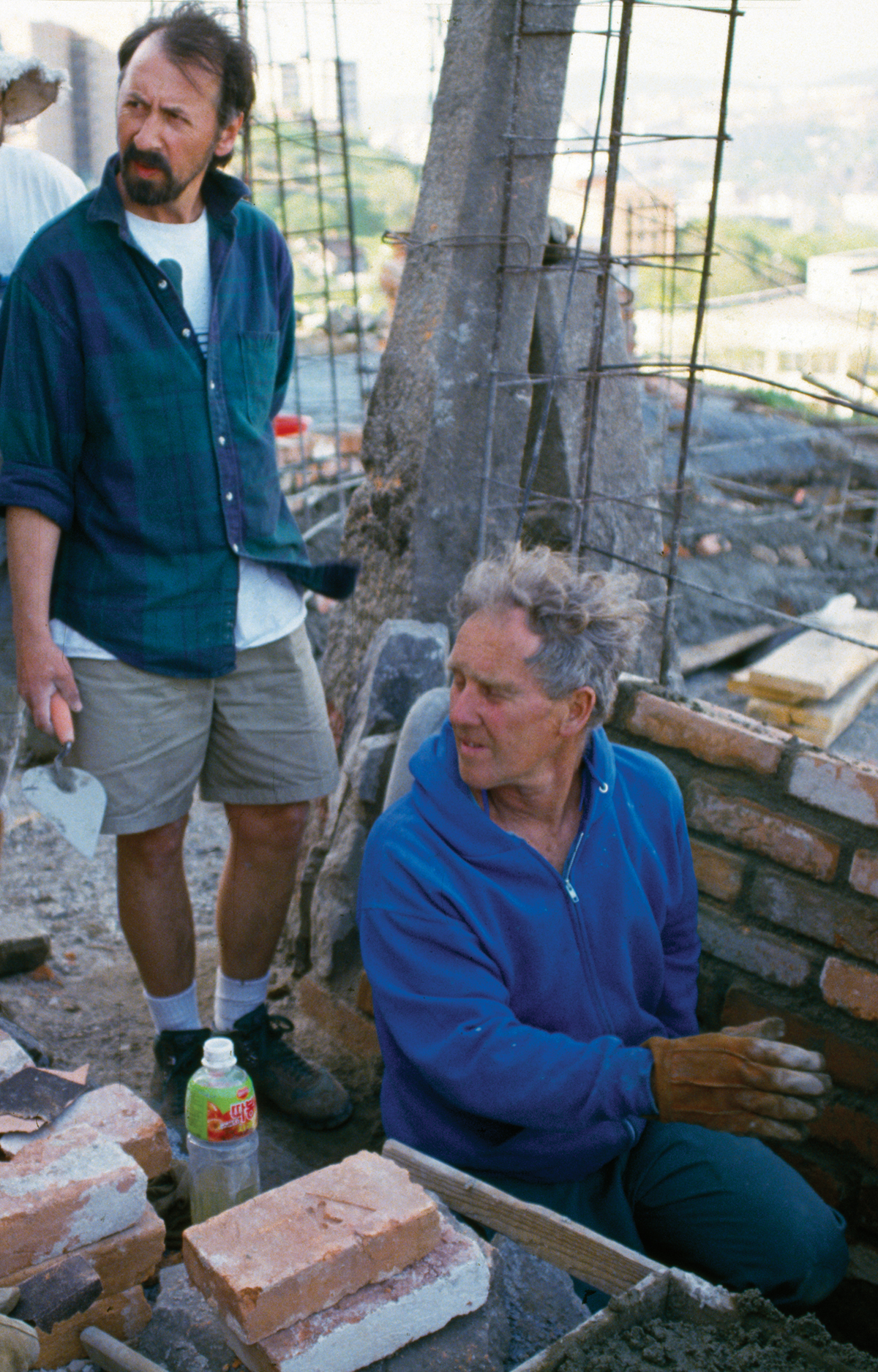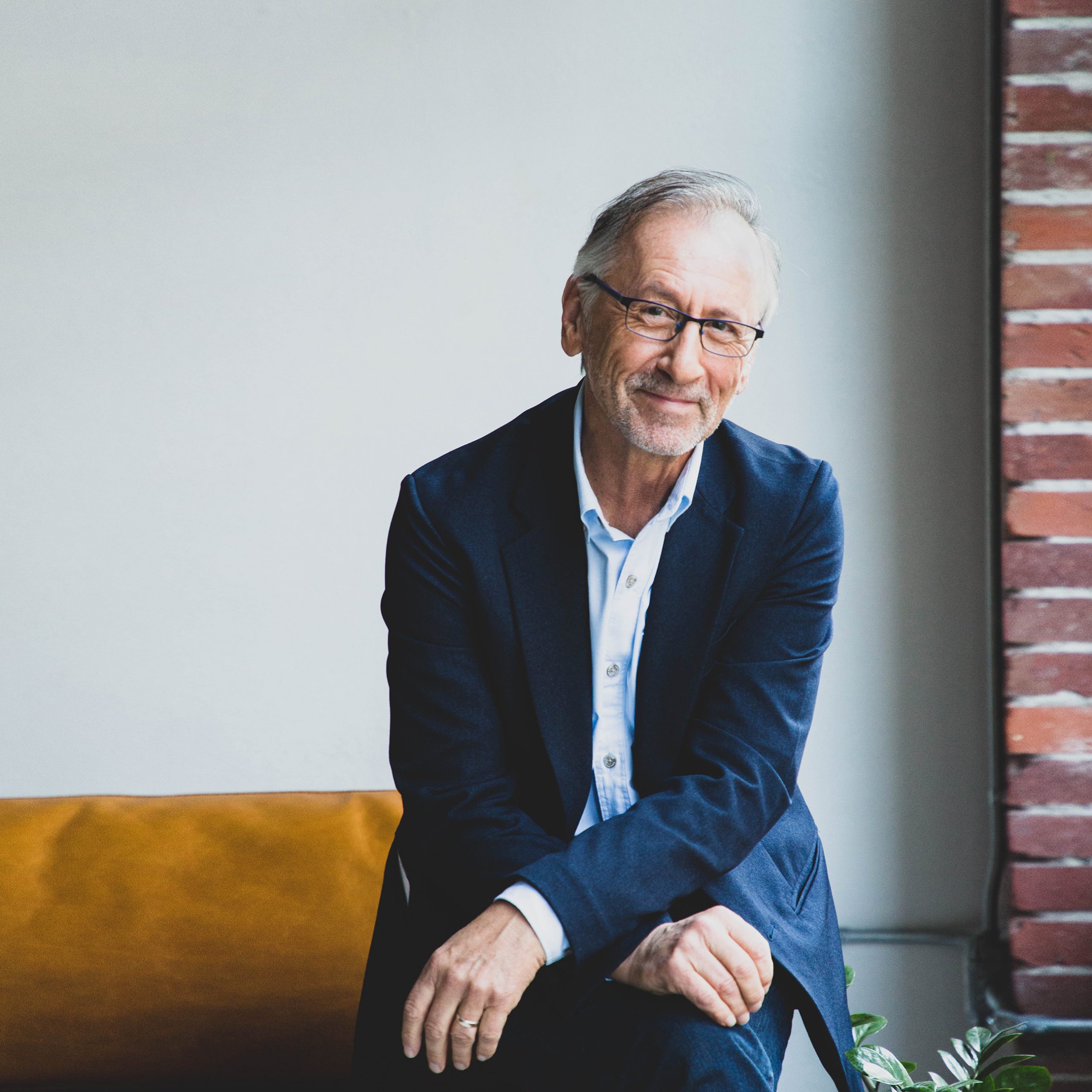We all worked hard because we saw James working hard. There were moments when I thought I was just too exhausted to continue, but then I looked over, and there was James working on into the evening. Inspired by his determination, we all became stronger and more willing to stretch beyond limits. Ever since, I’ve tried to be a leader that models for others what needs to be done, and not ask others to do things I am unwilling to do myself.
James Hubbell and I became friends in 1984 when I interviewed him for my book “LightWorks.” I was a recovering artist at the time, having left the world of museums and galleries to explore how my creative skills could be used in society at large. I instantly recognized that James’s mission matched mine: to push art into life, and that there is nowhere art can’t be.
Since 1984, we’ve seen each other at least once a year, and whenever we can, we do watercolors together. We happily compete to see who can produce the most watercolors! Sitting together, we steal ideas and learn from each other. Most importantly, we always have fun. Somewhere along the way — without fail — James will say, “This is so much fun it should be illegal.” And he and I chuckle like kids, knowing well what a special treat it is for us to enjoy ourselves so much while reaffirming that our world is better when more people make art.
What jumps out about James is his commitment to infusing everything with artistry: in the case of his architecture, the site, walls, roofs, windows, benches, floors—all are outlets for making a more beautiful world. Walking around the buildings at his home on my first visit, I could imagine the endless hours of art-making and hard physical work that went into building his campus. Ever since, I’ve thought of Jim as an artist and builder, able to work on the most delicate details while also building walls, lifting rocks, mixing concrete, welding. Later, when we worked side by side, I was impressed by his dogged endurance. From the very beginning, he struck me as a strong person, with the right balance of healthy ego and humility. Building his home/campus required this combination of skills and sensibilities.
Much of modern art focuses on its various components. In the last century, we witnessed wave upon wave of different styles. Some artists zeroed in on color, some on textures and patterns, yet others on abstracted composition, and so on, each presenting their work as the total package. Along the way, our eyes became more attuned to those different elements of our visual world. Their gift was to bring to light things we would initially fail to see. But these waves of modern art also created a shadow, in which we somehow lost track of how it all works together.

Milenko and James at Vladivostok, 1994 Courtesy of Ilan-Lael Foundation
James is different. He is interested in how things fit together: a building with the land, a sculpture with its surrounding space, a mosaic with the wall, a stained-glass art piece with the light that falls on it, and so on. James’s art is total. It spills into everything. It is integrated with the rest of life rather than neatly contained in its own compartment. In my 1984 interview, he told me:
I like to use materials and weave them back and forth. To me, tile isn’t separate from cement. They all flow together. Art is learning how to be quiet; to listen to what the situations want to say; it’s a conversation. I do a drawing, I put a line down, and it says ‘put a curved line next to me.’ I just feel that it wants me to do that … The tree has its own language and cannot fail when it acts out of that language. So, once I get into the spirit of a place, whatever comes out of it is right and has integrity.
Early on James and I talked about whether it was possible for a group of strangers to come together and create something of value. The opportunity to test this idea came in 1990 when Deborah Szekely and her daughter Sarah Livia Brightwood, co-owners of Rancho La Puerta, invited James and me to create an art piece celebrating the Rancho’s 50th anniversary. James would serve as the artistic director, and I would engage the team of 12 volunteers and builders in the design process. The rules of the project, as set up by Sarah, were that we create something to honor Mt. Kuchumaa, a sacred mountain which soars above the land; use local brick and rock; and complete the project in ten days. Those challenging constraints helped us invent a process that had to balance design thoroughness with speed.
It started with two days spent learning about the site and local art and architecture. We walked the land and slept on the ground and listened to the history of the area. This led to two days of collaborative design-making. Then James used his experience to finalize the design, synthesizing the many ideas that surfaced along the way. The final six days were all about building — long days where hard work coexisted with joy and satisfaction. This continuous process became possible only by trusting that one right step leads to the next and that it all adds up to something meaningful and beautiful.
We all worked hard because we saw James working hard. There were moments when I thought I was just too exhausted to continue, but then I looked over, and there was James working on into the evening. Inspired by his determination, we all became stronger and more willing to stretch beyond limits. Ever since, I’ve tried to be a leader that models for others what needs to be done, and not ask others to do things I am unwilling to do myself.
Kuchumaa Passage turned out to be a surprisingly effective process. It was not that James and I did not plan the project. We did — to the best of our abilities. However, at the core of this experiment resided our faith that as long as we paid attention to the site and the mountain, to our coworkers and their skills and abilities, and to local materials, things would work out. We created beautiful artwork while generating joy and pride for all involved. It also proved to be a very energy-efficient way of making art and building community.
James and I were both eager to find new ways to utilize this method. For James, it naturally evolved into Pacific Rim Park. In addition to stumbling onto a beneficial process, both of us sensed that the currently dominant European influences needed to be balanced with those of other cultures. James did a stint in the Army in Korea and fell in love with that country and by extension other countries around the Pacific Rim. There was a richness of traditions and ways of thinking and being that needed to talk with each other. We wondered: what if we imagine projects around the Pacific Rim, and those projects are built by individuals from those various traditions? The process and the results would celebrate the exchange. Why not?
I helped James with the four initial projects, each time integrating lessons from Kuchumaa Passage into month-long projects. The conditions were different, but the principles remained the same. This book does the deep dive into all those projects.
I applied this way of working at Pomegranate Center, a non-profit organization in Seattle that I started in 1986 with the mission to link art with community engagement. We have built some 60 projects, working with all kinds of people, artists or not, old and young, and from all walks of life. We invite people to become artists and creators for a few days. Along the way, people come to respect and trust each other more, feel safer, and when it ends are eager to jump into future projects. This is good for democracy. The process has proven to be a fantastic way to build ‘social capital’ — which is to a community what money is to finances.
Why do these projects matter? Because in the future, we will all need to learn how to work with each other better. The collaboration will be the name of the game, and it must be practiced and not just talked about. We need to see people’s differences as valuable assets and not irritations. Participatory projects are engines for learning — prototypes for something that will become normal.
Our cities will have spaces that are for mystery and wonder, not just practical and functional and easy to maintain — spaces created with lots of hands. What will happen to all of us as artificial intelligence takes many jobs? I think that we should channel the extra energy into artistry, creating homes and furniture and textiles and gardens and parks by hand, with neighbors. We have the opportunity to stop being just producers. We can turn ourselves into creators and artisans and artists. In other words, the future world will be shaped by all of us, not just by those on top.
The next step in this work may well be training. The process, first tested with Kuchumaa Passage and then refined through dozens of projects, must be taught and practiced. Every project becomes a classroom to build new leaders, help local partners develop new capacities, and leave behind not only a beautiful art-filled place but the understanding of a collaborative process that can be applied to just about any project.
I see Pacific Rim Park’s and Pomegranate’s gathering places as how-to-do-it laboratories and research centers on a small scale. The time is ripe to do it everywhere, with more artists, more communities, and more partners. And then one project will tell where the next one should be, and a small movement will begin in each of the participating communities, and each project will give birth to new ones. This will be so much fun that it will be required by law.
